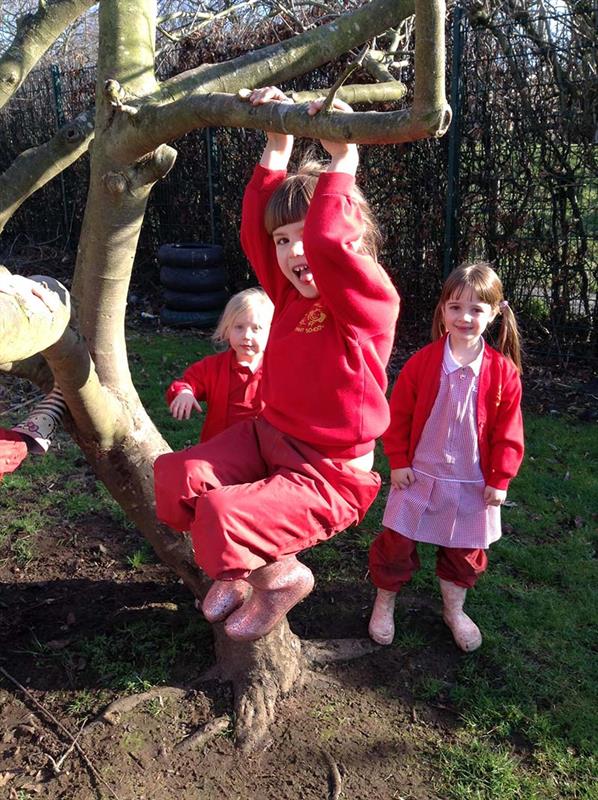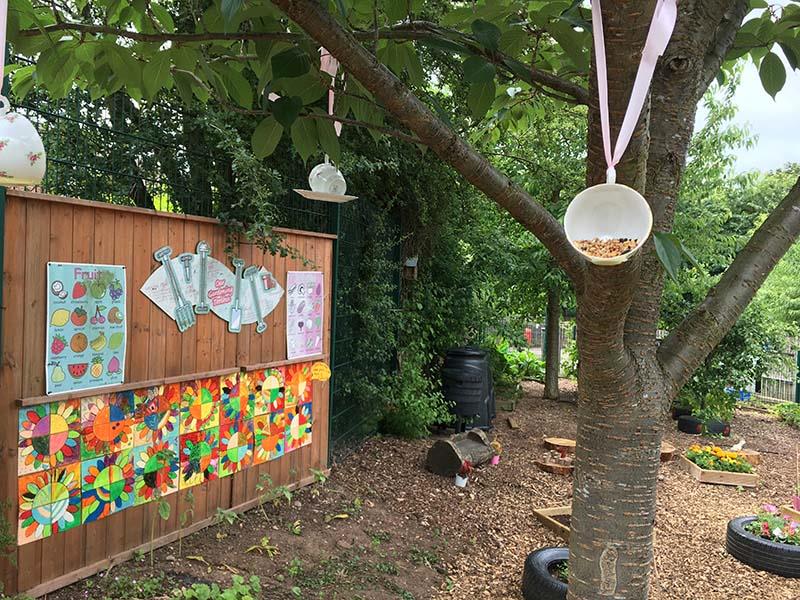Every child at Ernehale Infant School gets the chance to take part in a forest school session for a whole afternoon each week.
The 210 pupils, all aged between four and seven, enjoy activities like pond-dipping, building dens and shelters, climbing trees, whittling sticks, learning to tie knots and toasting marshmallows and popcorn by the fire. The children bring their own wellies but the school supplies their red waterproof trousers and jackets and they head outdoors to the forest school on the school site in all weathers, come rain or shine.
The sessions start with a warm-up on an obstacle course made of old tyres. Then the children move to the meadow, sit in a circle and sing their own forest school song, which they have learned by heart.
The children made the song up themselves and it summarises the forest school rules. The song reminds them not to eat berries or seeds, to walk rather than run and to return to the circle when their teacher blows the whistle. One verse goes: “Bugs and insects on the ground, Watch them run and wriggle around, Get down closely, take a look, But do not squish them with your foot.”
Ernehale Infant School, which is situated in a residential area three miles from Nottingham city centre, launched its forest school eight years ago. As well as a meadow area, the forest school has a woodland, a pond, an outdoor classroom made from a poly-tunnel, a digging area, a mud kitchen and “bug hotels” to attract wildlife.
Headteacher Emma Johnson believes that the forest school sessions are invaluable and enable the teaching staff to develop “the whole child”.
“We have four school values that we abide by, making sure that the children are respectful, responsible, risk-takers and resilient,” she explained. “Forest school is a really good opportunity to make sure we are embedding those values in the children away from the mainstream curriculum.”
Assistant headteacher Lucinda Cox is the school’s SENCO and forest school lead. She continued: “We tend to have our whole class forest sessions in the afternoons so they don’t impact on the core learning in the morning. But some of our more vulnerable pupils, the children who need a break from the mainstream curriculum, have an additional forest school session in the mornings.”
Experts agree that children benefit hugely from attending forest school sessions. A recent Loughborough University study found that forest schools give children the opportunity to learn important skills that are not taught in the classroom, such as resilience and independence (Pimlott-Wilson & Coates, 2019).
The research, carried out by Dr Helena Pimlott-Wilson and Dr Janine Coates and published in The Geographical Journal, also revealed that learning outside the classroom can give children a sense of freedom and can influence their attitudes towards learning.
The two academics talked to teachers and pupils at two primary schools in the Midlands (not Ernehale Infant School) and discovered that youngsters also develop social skills, problem-solving skills, creativity and social and environmental responsibility – qualities that prepare them for later life.
Dr Coates explained: “Children work more closely with their peers to achieve common goals and this helps them to not only develop and strengthen their friendships, but to learn and apply social skills like negotiation, conflict, resolution and diplomacy.”
Interestingly, pupils from the two primary schools featured in the Loughborough University study saw forest school as an environment where they gained useful knowledge in a hands-on and playful manner. However, they did not necessarily see what they learned as “educational”.
Forest schools were pioneered in the UK by Bridgwater and Taunton College. Nursery nurses from the college visited Denmark in 1993 and were impressed by the way that Danish schools took children out of the classroom and taught them in the countryside. They were so inspired by the outdoor, child-centred and play-based approach to early years education that on their return they started their own forest school. The idea took off and now many primary schools have forest schools.

Back at Ernehale, Ms Cox, who has a Level 3 forest school qualification, trains the school’s seven class teachers. They each take ownership of their classes’ forest school sessions, linking the activities to the children’s indoor learning as much as they can.
“When we did our circus topic we brought it into the forest,” said Ms Cox. “The children made see-saws out of planks and crates and became trapeze artists, balancing along logs. We also let them climb trees to a reasonable height.”
The Ernehale pupils’ favourite activities include making mud pies in the mud kitchen and sitting by the fire with hot chocolate.
“Halfway through the session we blow the whistle and they all come back,” said Ms Cox. “We wash our hands, have hot chocolate and biscuits and reflect on our learning. Someone might bring something interesting to show or we might have a story and a sing-song.
“Forest school doesn’t have the constraints of the indoor curriculum. We encourage the older children to direct their own learning so the practitioners step back and we only intervene as and when they need us.”
The teachers have observed that the pupils often change when they are outside. “They flourish in the outdoor environment,” Ms Cox added. “The children who are reluctant to speak might be giggling with their friends whereas in the classroom they may self-lack confidence and don’t speak out.”
Ms Johnson continued: “We had one child who was completely non-verbal in class but when you take her out into the forest, without the constraints or expectations of the mainstream classroom, she will chatter away. It gives her an outlet and she has started to bring that learning and confidence back into the classroom.”
As concern grows about the amount of time children spend on computer screens, forest schools provide a time away from technology. The teaching staff at Ernehale sometimes take photographs of forest school activities but the school does not use screens as a learning tool in the forest.
The forest school sessions also boost the pupils’ creativity. “We always make sure they get the opportunity to write about what they’re doing,” Ms Cox explained. “If they are making mud pies the children will often write recipes and menus and take orders.”
The children’s understanding of science and nature has grown too. “A lot of our children don’t necessarily get the opportunity for outdoor play at home,” said Ms Johnson. “We understand that parents are busy and the children don’t always have the opportunity to get outside and get mucky at weekends but our forest school has helped our pupils to be much more respectful of the environment.”

Ms Cox has noticed that even though some young children are unsure about playing in the mud at first they soon learn to enjoy it.
“In September there are some children who aren’t keen to get their hands dirty but as the weeks go by their confidence builds,” she said. “They realise that it’s safe to get a bit muddy sometimes and by the end of the year they really enjoy it. They learn so much about nature from being outside in all weathers and through the seasons.”
Buoyed by the success of the forest school, the team at Ernehale has recently launched a sensory garden, complete with planters to grow flowers and old teacups filled with bird seed hanging from the trees.
“We are so pleased at how successful the forest school has been in giving the children opportunities to learn outside that we wanted to develop another space for them,” said Ms Johnson.
“Now that we have the sensory garden the children have ownership of growing things from seed to shoot. They’ve already grown strawberries and taken them home.”
The Ernehale parents are very supportive of the forest school too. Many of them choose to send their children to the school specifically because of the outdoor learning it provides.
“When the children go home they wax lyrical about what they have done in the forest and their personal achievements,” said Ms Johnson. “The parents see it as such a beneficial thing for the children to do.”
At the end of year 2, most of the pupils at the infant school progress to Ernehale Junior School, which is on the same site. Staff at the junior school are keen to develop their own forest school and have asked Ms Johnson and Ms Cox for ideas about how they can emulate it.
“Some people think that forest school is just for the early years – but it isn’t,” said Ms Johnson. “Children need an outlet away from the mainstream classroom and forest school provides it.”
- Emma Lee-Potter is a freelance education writer.
Further information & resources
- Rethinking learning? Challenging and accommodating neoliberal educational agenda in the integration of forest school into mainstream educational settings, Pimlott-Wilson & Coates, The Geographical Journal, June 2019: http://bit.ly/2MZDwzm
- See also: Learning while playing: Children’s forest school experiences in the UK, Coates & Pimlott-Wilson, British Educational Research Journal, October 2018: http://bit.ly/2KvWrQu
